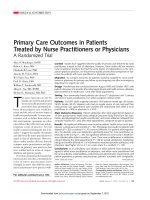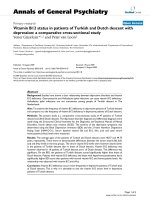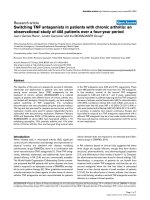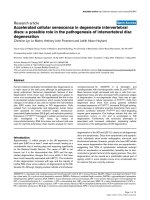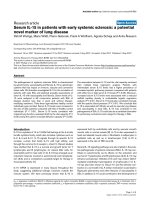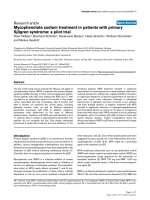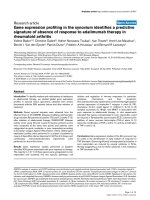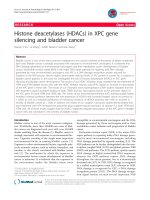Báo cáo y học: "Skin prick testing in patients using beta-blockers: a retrospective analysis" pot
Bạn đang xem bản rút gọn của tài liệu. Xem và tải ngay bản đầy đủ của tài liệu tại đây (170.84 KB, 4 trang )
RESEARC H Open Access
Skin prick testing in patients using beta-blockers:
a retrospective analysis
Irene N Fung
1
, Harold L Kim
1,2*
Abstract
Rationale: The use of beta-blockers is a relative contraindication in allergen skin testing yet there is a paucity of
literature on adverse events in this circumstance. We examined a population of skin tested patients on beta-
blockers to look for any adverse effects.
Methods: Charts from 2004-2008 in a single all ergy clinic were reviewed for any patients taking a beta-blocker
when skin tested. Data was examined for skin test reactivity, type of skin test, concomitant asthma diagnosis,
allergens tested, and adverse events.
Results: One hundred and ninety-one patients were taking beta-blockers when skin testing occurred. Seventy-two
patients had positive skin tests. No tests resulted in an adverse event.
Conclusions: This data demonstrates the relative safety of administrating of skin prick tests to patients on beta-
blocker treatment. Larger prospective studies are needed to substantiate the findings of this study.
Introduction
Beta antagonists, commonly known as beta-blockers, are
a commonly prescribed class of medications. Beta-block-
ers are used in the treatment of congestive heart failure,
coronary heart disease, cardiac arrhythmia, hypertension,
tremor, glaucoma, and migraine h eadache. Importantly,
beta-blockers signifi cantly reduce both morbidity and
mortality rates in congestive heart failure, in acute cor-
onary syndrome, and post myocardial infarction [1-3].
However, beta-blockade may place atopic subjects at an
increased risk of an anaphylactic reaction. Case reports
suggest tha t whe n systemic allergic reactions occur sec-
ondary to immunotherapy, drugs, foods, and insects
stings, they may be of greater severity in patients taking
beta-blockers [4-11].
Due to the potential of beta-blockers to amplify the
effects of anaphylaxis, these drugs are relatively contra-
indicated during allergy skin testing. The American
Academy of Allergy Asthma & Immunology (AAAAI)
outlines t his in its position statement, stating that “Sys-
temic reactions to skin testing are rare. Nevertheless,
special precautions, when these are appropriate, should
be taken when the patient who needs sensitivity testing
for IgE-mediated d isease cannot stop trea tment with a
beta-blocking agent [12].” However, in our literature
review on the topic, no case reports or prospective stu-
dies report adverse events in patients on beta-blockers
who underwent skin testing. This retrospective study
investigates whether there is any increased risk of ana-
phylaxis in patients who were allergy skin tested while
they continued on a beta-blocker medication.
Methods
Charts of all patients seen at an allergy clinic in Kitch-
ener, Ontario from 2004 and 2008 were searched for
any beta-blocker use at the time of their clinic visit.
Theserecordswereexaminedtoidentifyifanyindivi-
duals who were skin tested, while they continued to
take beta-blockers, had any reactions to the skin testing.
The charts of the patients who were found to be aller-
gic, based on skin testing, were further analysed regard-
ing the medical history, type of beta-blocker t aken and
skin test findings.
Results
One hundred and ninety-one patients were identifi ed to
be taking beta-blockers while undergoing skin testing.
From the review of their charts, none of these patients
experienced any adverse event secondary to skin testing.
* Correspondence:
1
McMaster University, Hamilton, Ontario, Canada
Fung and Kim Allergy, Asthma Clinical Immunology 2010, 6:2
/>ALLERGY, ASTHMA & CLINICAL
IMMUNOLOGY
© 2010 Fung and Kim; licensee BioMe d Ce ntral Ltd. This is an Open Access article distributed under the terms of the Creative
Commons Attribution License ( which permits unrestricted use, distribution, and
reproduction in any medium, provided the original work is properly cit ed.
Specifically, there were no cases of anaphylaxis in t hese
patients. Also, all patients who were taking beta-blockers
at the time of the allergy consultation were skin tested.
Seventy-two patients on beta-blockers had positive
results on skin testing, thus demonstrating an IgE-
mediated sensitivity. The mean age of these patients was
60 (range 34-89), and 58% of these patients were male.
Some other demographic data for the patients with posi-
tive skin test results is reported in Table 1. A few
patients had more than one primary reason for referral.
Spirometry findings and concomitant medications are
also presented in t he table as these two factors could
have affected the severity of an anaphylactic reaction.
Fifteen of the 72 allergic patients also had spirometry
testing completed because they had some clinical history
of respiratory symptoms. Two of the 15 had an obstruc-
tive pattern on their spirometry, as indicated by having
a FEV1/FVC < 75% predicted. One patient was taking
cetirizine and another was taking amitriptyline at the
time of skin testing. These medications may have
blunted the skin test response. Other common concomi-
tant medications included HMG-CoA reductase inhibi-
tors, diuretics, acetylsalicylic acid, angiotensin
converting enzyme inhibitors, and calcium channel
blockers.
The types of beta-blocke rs taken by the 72 patients
with positive skin findings are summarized in table 2.
The majority of patients were on oral agents, with ate-
nolol and propanolol being the most commonly used.
Two patients were taking ocular topical beta-blocking
agents. Table 3 shows the indications for beta-blocker
use. A few patients had more than one indication docu-
mented in their charts.
The allergens the 72 allergic patients tested positive to
are listed in table 4. The majority of positive reactions
were to envir onmental aeroallergens and insect venoms,
but some patients were found to be allergic to latex,
foods and penicillin.
Discussion
Beta-blockers are relatively contraindicated in both skin
testing and immunotherapy for three reasons. They
may: 1) worsen anaphylaxis severity; 2) make treatment
of anaphylaxis more difficult; and 3) increase the inci-
dence of anaphylaxis itself. First, in terms of anaphylaxis
severity, beta-blockers can increase synthesis and release
Table 1 Characterization of Atopic Patients Assessed (N = 72)
n (%)
Reason for referral
General allergy assessment 34 (47)
Environmental allergies 13 (18)
Rhinitis or sinusitis 7 (10)
Anaphylactic event 5 (7)
Rash or urticaria 5 (7)
Food allergy 4 (6)
Asthma 4 (6)
Angioedema 3 (4)
Cough 3 (4)
Drug allergy 2 (3)
Spirometry performed 15 (21)
FEV1% <80% predicted 3 (4)
FEV1/FVC % <75% predicted 2 (13)
Other medications
HMG-CoA reductase inhibitor Iinhibitors inhibitors 22 (31)
Diuretic 19 (26)
ASA 18 (25)
ACEi 14 (19)
CCB 10 (14)
Amitriptyline 1 (1)
Cetirizine 1 (1)
ASA - acetyl salicylic acid, ACEi - angiotensin converting enzyme inhibitor, CCB - calcium channel blocker
Fung and Kim Allergy, Asthma Clinical Immunology 2010, 6:2
/>Page 2 of 4
of anaphylactic mediators [13,14], as well as enhance
responsiveness of organs to the mediators released
[15-18]. In atopic subjects, total IgE production may
increase. Those with allergic asthma already have exces-
sive alpha-adrenergic reactivity and beta-blockade may
further exacerbate this problem. In the treatment of
anaphylaxi s, beta-b lockade has been shown to blunt the
effect of epinephrine in animal and human models
[19-22]. Finally, in case reports of patients with severe
anaphylactic reactions, several patients were coincidently
on beta-blocker medications [23-29].
While all of the issues above concerning beta-blockers
and anaphylaxis are important, we argue that with
allergy skin prick testing and intradermal testing with
insect venoms and penicillin, the risk of anaphylaxis is
so low that testing can be completed safely on most
patients taking beta-blockers. Our study failed t o show
any adverse events in patients undergoing skin testing
while taking beta-blockers. Because systemic reactions
to skin testing are so uncommon, larger prospective stu-
dies comparing patients who a re taking and not taking
beta-blockers should be performed to prove any risk of
beta-blocker use. It is important t o note that fatalities
from skin testing regardless of beta-blocker use are
extremely rare. Through a national questionnaire study
with members of the American Academy of Allergy and
Immunology, seven fatalities are known: two occurring
in 1964, four between 1980-1983, and one in a more
recent report surveying the period between 1990-2001
[30-32]. None of these patients were known to be using
beta-blockers. Furthermore, we could not find any pub-
lished reports identifying any life-threatening or fatal
reactions when patients taking beta-blockers were skin
prick tested. In contrast , there are 88 reports from the
American Academy of Allergy and Immunology over
this time of allergen immunother apy fatalities, with 3 of
these patients taking beta-blockers [33-35]. Thus, while
there may be an increased risk of anaphylaxis in patients
on beta-blockers undergoing immunotherapy, the degree
of risk is likely smaller in patients undergoing allergy
skin testing. Of course, standard safety measures should
still be available in the clinics where skin testing is
being performed.
This study provides information regarding the safety
of skin prick testing in patients taking beta-blocker
medications. To date, this is the first study known
which assesses this issue specifically. Our retrospective
study showed no adverse effects of skin testing in 191
patients on beta-blockers. The fact that 72 patients with
positive skin tests were a ble to tolerate the skin testing
without any problems suggests skin testing is likely a
Table 2 Assessment of beta-blockers used by patients (N
= 72)
n (% patients)
Beta-blocker route
Oral 70 (97)
Ocular 2 (3)
Beta-blocker name
Atenolol 42 (58)
Metoprolol 15 (21)
Nadolol 4 (6)
Acebutalol 4 (6)
Propanolol 2 (3)
Bisprolol 2 (3)
Timolol 1 (1)
Labetolol 1 (1)
Table 3 Indications for beta-blocker use (N = 72)
n (%)
HTN 49 (68)
CAD 17 (24)
MI 7 (10)
Headache 2 (3)
Glaucoma 2 (3)
Arrhythmia 2 (3)
Tremor 1 (1)
HTN = hypertension, CAD = coronary artery disease, MI = myocardial infarction
Table 4 Positive skin tests (N = 72)
Number positive (%)
Ragweed 25 (35)
Tree 24 (33)
Grass 24 (33)
Mold 22 (31)
Dust mite 22 (31)
Cat 15 (21)
Yellow jacket* 15 (21)
Wasp* 11 (15)
Yellow hornet* 10 (14)
White faced hornet* 9 (13)
Dog 7 (10)
Guinea pig 3 (4)
Seafood 3 (4)
Hamster 2 (3)
Fruit 2 (3)
Latex 2 (3)
Nut 2 (3)
Horse 1 (1)
Vegetable 1 (1)
Penicillin* 1 (1)
Honeybee* 1 (1)
*Intradermally tested
Fung and Kim Allergy, Asthma Clinical Immunology 2010, 6:2
/>Page 3 of 4
safe procedure in most patients on beta-blockers. How-
ever, large multi-center prospective studies are required
to truly measure any increased risk of anaphylaxis of
allergy skin testing in patients taking beta-blockers.
Until these larger studies are performed, skin testing
should still be performed with caution in patients taking
beta-blocker medications.
Acknowledgements
We wish to acknowledge Dr. David Fischer for his help in reviewing this
paper.
Author details
1
McMaster University, Hamilton, Ontario, Canada.
2
University of Western
Ontario, London, Ontario, Canada.
Authors’ contributions
IF helped to design the study, collected the data for analysis and wrote the
paper. HK conceived the study and participated in its design and writing. All
authors read and approved the final manuscript.
Competing interests
The authors declare that they have no competing interests.
Received: 11 December 2009
Accepted: 20 January 2010 Published: 20 January 2010
References
1. Foody JM, Farrell MH, Krumholz HM: Beta-Blocker Therapy In Heart
Failure: Scientific Review. JAMA 2002, 287(7):883-889.
2. Yusef SPRLJCRSP: Beta Blockade During And After Myocardial Infarction:
An Overview Of The Randomized Trials. Prog Cardiovasc Dis 1985,
27(5):335-371.
3. Freemantle N, Cleland J, Young P, Mason J, Harrison J: Beta Blockade After
Myocardial Infarction: Systematic Review And Meta Regression Analysis.
BMJ 1999, 318(7200):1730-1737.
4. Momeni M, Brui B, Baele P, Matta A: Anaphylactic Shock In A Beta-Blocked
Child: Usefulness Of Isoproterenol. Paediatr Anaesth 2007, 17(9):897-899.
5. Jacobs RL, Rake Gw Jr, Fournier Dc, Chilton RJ, Culver WG, Beckmann CH:
Potentiated Anaphylaxis In Patients With Drug-Induced Beta-Adrenergic
Blockade. J Allergy Clin Immunol 1981, 68(2):125-127.
6. Newman BR, Schultz LK: Epinephrine-Resistant Anaphylaxis In A Patient
Taking Propranolol Hydrochloride. Ann Allergy 1981, 47(1):35-37.
7. Hannaway PJ, Hopper GD: Severe Anaphylaxis And Drug-Induced Beta-
Blockade. N Engl J Med 1983, 308(25):1536.
8. Awai LE, Mekori YA: Insect Sting Anaphylaxis And Beta-Adrenergic
Blockade: A Relative Contraindication. Ann Allergy 1984, 53(1):48-49.
9. Ingall M, Goldman G, Page LB: Beta-Blockade In Stinging Insect
Anaphylaxis. JAMA 1984, 251(11):1432.
10. Berkelman RL, Finton RJ, Elsea WR: Beta-Adrenergic Antagonists And Fatal
Anaphylactic Reactions To Oral Penicillin. Ann Intern Med 1986, 104(1):134.
11. Stark BJ, Sullivan TJ: Biphasic And Protracted Anaphylaxis. J Allergy Clin
Immunol 1986, 78(1 Pt 1):76-83.
12. American Academy Of Allergy Asthma & Immunology: Academy Position
Statement: Adrenergic Blockers, Allergen Immunotherapy And Skin
Testing. AAAAI Media Center 2002 />Academy_Statements/Position_Statements/Blockers_Immuno_Skin.Asp,
[Cited 8 A.D. Nov 7].
13. Kaplan AP, Anderson JA, Valentine MD, Lockey RF, Pierson WE, Zweiman B,
et al: Beta-Adrenergic Blockers, Immunotherapy, And Skin Testing.
American Academy Of Allergy And Immunology. J Allergy Clin Immunol
1989, 84(1):129-130.
14. Mjorndal TO, Chesrown SE, Frey MJ, Reed BR, Lazarus SC, Gold WM: Effect
Of Beta-Adrenergic Stimulation On Experimental Canine Anaphylaxis In
Vivo. J Allergy Clin Immunol 1983, 71(1 Pt 1):62-70.
15. Shereff RH, Harwell W, Lieberman P, Rosenberg EW, Robinson H: Effect Of
Beta Adrenergic Stimulation And Blockade On Immediate
Hypersensitivity Skin Test Reactions. J Allergy Clin Immunol 1973,
52(6):328-333.
16. Nisam MR, Zbinden A, Chesrown S, Barnett D, Gold WM: Distribution Of
And Pharmacological Release Of Histamine In Canine Lung In Vivo. J
Appl Physiol 1978, 44(3):455-463.
17. Matsumura Y, Tan EM, Vaughan JH: Hypersensitivity To Histamine And
Systemic Anaphylaxis In Mice With Pharmacologic Beta Adrenergic
Blockade: Protection By Nucleotides. J Allergy Clin Immunol 1976,
58(3):387-394.
18. Matsumura Y, Tan EM, Vaughan JH: Histamine Hypersensitivity In Mice
Induced By Bordetella Pertussis Or Pharmacologic Beta Adrenergic
Blockade. Effects Of Adrenergic, Cholinergic, And Other Drugs. J Allergy
Clin Immunol 1976, 58(3):395-404.
19. Kim Y: Interaction Between Beta Blockers And Epinephrine On
Hemodynamics Of Spontaneously Hypertensive Rats. Res Commun Chem
Pathol Pharmacol 1993, 80(1):3-19.
20. Matsumura Y, Tan EM, Vaughan JH: Hypersensitivity To Histamine And
Systemic Anaphylaxis In Mice With Pharmacologic Beta Adrenergic
Blockade: Protection By Nucleotides. J Allergy Clin Immunol 1976,
58(3):387-394.
21. Forfang K, Simonsen S: Effects Of Atenolol And Pindolol On The
Hypokalaemic And Cardiovascular Responses To Adrenaline Infusion. Eur
J Clin Pharmacol 1989, 37(1):23-27.
22. Raptis S, Rosenthal J, Welzel D, Moulopoulos S: Effects Of Cardioselective
And Non-Cardioselective Beta-Blockade On Adrenaline-Induced
Metabolic And Cardiovascular Responses In Man. Eur J Clin Pharmacol
1981, 20(1):17-22.
23. Momeni M, Brui B, Baele P, Matta A: Anaphylactic Shock In A Beta-Blocked
Child: Usefulness Of Isoproterenol. Paediatr Anaesth 2007, 17(9):897-899.
24. Jacobs RL, Rake GW Jr, Fournier DC, Chilton RJ, Culver WG, Beckmann CH:
Potentiated Anaphylaxis In Patients With Drug-Induced Beta-Adrenergic
Blockade. J Allergy Clin Immunol 1981, 68(2):125-127.
25. Newman BR, Schultz LK: Epinephrine-Resistant Anaphylaxis In A Patient
Taking Propranolol Hydrochloride. Ann Allergy 1981, 47(1):35-37.
26. Hannaway PJ, Hopper GD: Severe Anaphylaxis And Drug-Induced Beta-
Blockade. N Engl J Med 1983, 308(25):1536.
27. Awai LE, Mekori YA: Insect Sting Anaphylaxis And Beta-Adrenergic
Blockade: A Relative Contraindication. Ann Allergy 1984, 53(1):48-49.
28. Ingall M, Goldman G, Page LB: Beta-Blockade In Stinging Insect
Anaphylaxis. JAMA
1984, 251(11):1432.
29. Berkelman RL, Finton RJ, Elsea WR: Beta-Adrenergic Antagonists And Fatal
Anaphylactic Reactions To Oral Penicillin. Ann Intern Med 1986, 104(1):134.
30. Lockey RF, Benedict LM, Turkeltaub PC, Bukantz SC: Fatalities From
Immunotherapy (IT) And Skin Testing (ST). J Allergy Clin Immunol 1987,
79(4):660-677.
31. Reid MJ, Lockey RF, Turkeltaub PC, Platts-Mills TA: Survey Of Fatalities
From Skin Testing And Immunotherapy 1985-1989. J Allergy Clin Immunol
1993, 92(1 Pt 1):6-15.
32. Bernstein DI, Wanner M, Borish L, Liss GM: Twelve-Year Survey Of Fatal
Reactions To Allergen Injections And Skin Testing: 1990-2001. J Allergy
Clin Immunol 2004, 113(6):1129-1136.
33. Lockey RF, Benedict LM, Turkeltaub PC, Bukantz SC: Fatalities From
Immunotherapy (IT) And Skin Testing (ST). J Allergy Clin Immunol 1987,
79(4):660-677.
34. Reid MJ, Lockey RF, Turkeltaub PC, Platts-Mills TA: Survey Of Fatalities
From Skin Testing And Immunotherapy 1985-1989. J Allergy Clin Immunol
1993, 92(1 Pt 1):6-15.
35. Bernstein DI, Wanner M, Borish L, Liss GM: Twelve-Year Survey Of Fatal
Reactions To Allergen Injections And Skin Testing: 1990-2001. J Allergy
Clin Immunol 2004, 113(6):1129-1136.
doi:10.1186/1710-1492-6-2
Cite this article as: Fung and Kim: Skin prick testing in patients using
beta-blockers: a retrospective analysis. Allergy, Asthma & Clinical
Immunology 2010 6:2.
Fung and Kim Allergy, Asthma Clinical Immunology 2010, 6:2
/>Page 4 of 4
